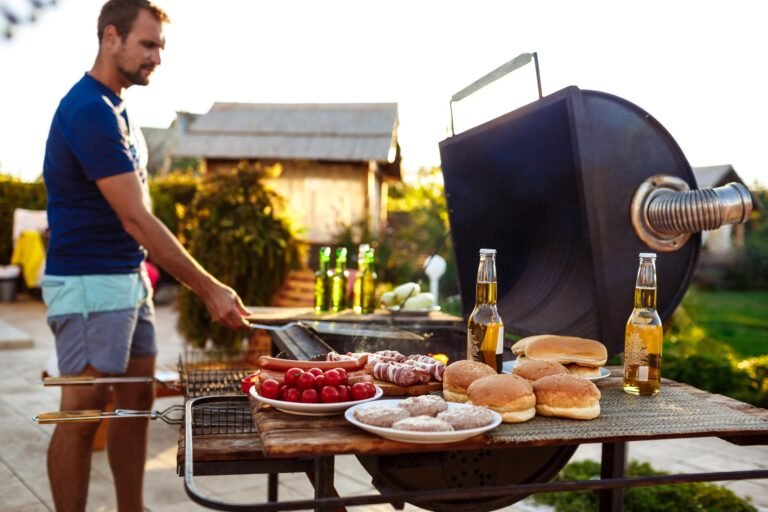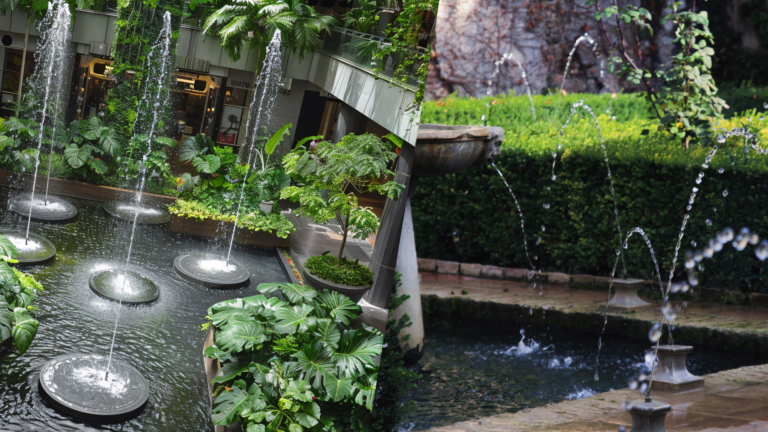Easy and Affordable Summer Garden Projects for Beginners
Summer is almost here! It’s the perfect time to give your garden a fresh look. Don’t worry if you’re new to gardening you don’t need to be an expert or spend a lot of money. There are many simple and budget-friendly ways to make your garden look great. You can brighten up your space with some colorful flowers or set up a comfortable spot to relax. There are endless options that are great for beginners.
Starting a garden project can be easy and affordable. All you need are a few basic tools and a bit of creativity to enhance both the look and use of your garden. Whether you have a tiny patio or a large backyard, this guide offers useful tips and exciting ideas that are simple to put into action. So, put on your gardening gloves, and let’s get started on some fun and budget-friendly projects that will make your summer garden lively and welcoming.
Why Garden in the Summer?
Summer gardening has some special charm and practical benefits. Warmth and length of the days are the very things that all plants need for development and growth. An abundance of sunlight is considered a vital factor for photosynthesis, a process that allows plants to convert light into energy; these are the factors that point out the likelihood of relatively high growth and healthy plants for summer months.
On top of these, summer is ideal for adding gardening as one of your additional pluses to accent your outdoor living space. Imagine a truly colorful place to entertain other people, or a quiet place just for you. A properly tended garden sets the stage. Additionally, it is one means of getting close to nature and is often taken as a relaxing activity that works against stress.
With such benefits come the economic ones, whereby growing your fruits, vegetables, and herbs reduces grocery bills. Tomatoes, peppers, and cucumbers are some of the most common plants grown during this period. Moreover, there is no food satisfaction better than that which comes from growing it yourself.
Finally, a garden started in the summer can be a great learning center for the family. It is a fun way to let the children learn about nature and how to take care of the surroundings. Therefore, summer gardening does not only enhance the beauty of your dwelling but also in so many other ways.
What are the Essential Tools and Materials for Beginners?
Gardening can be an exciting venture, yet having the right tools and materials is key to making sure your hard work blooms successfully. You don’t have to start with everything; it won’t be too overwhelming, and it won’t let you go broke either.
First and foremost, you’ll need some basic tools:
- Gardening gloves: They will prevent your hands from coming into contact with dirt, thorns, and chemicals.
- Spade and trowel: Use these for digging, planting, and moving soil.
- Pruning shears: Great for trimming plants and cutting back overgrowth.
- Watering can or hose: Keep your plants well-watered, especially as summer heats up.
- Rake: To clear leaves or level soil.
For materials, you should have the following:
- High-quality soil: Good soil is the foundation of a garden since it contains the most nutrients. Organic soil is recommended.
- Mulch: Helps keep the soil moist and stops the growth of weeds. Organic mulches like wood chips or straw break down over time and add nutrients to the soil.
- Seeds or starter plants: Some good choices for hardiness and ease of care are herbs, sunflowers, and marigolds.
- Fertilizer: Pick an all-purpose fertilizer to give plants essential nutrients and help them grow well.
The tools and materials will form a great start for your garden. They will help you easily and quickly perform all the necessary gardening activities, ensuring your summer garden remains healthy and full of life.
Project 1- Herb Garden

An herb garden will be a simple yet fulfilling project, ideal for novices as much as it is for seasoned gardeners this summer. Planting and taking care of herbs is simple, and they are quite versatile, from spicing up meals to making your garden beautiful.
Getting Started with Your Herb Garden: To start off, you should know that there are quite hardy herbs that therefore do not demand so much care. Good examples are the likes of basil, mint, cilantro, parsley, and chives. These kinds of herbs really thrive well in the hot summers and ideally can be grown either in open fields or even in pots.
Setting Up Your Garden: You can do so by planting your herbs in small pots, which in turn can be kept outside your balcony or patio, or you can set aside a small patch in your garden. Just make sure it gets at least six hours of sun every day and has good drainage to avoid rotting of the roots.
Planting: Sow seeds or seedlings into a well-prepared potting mix according to packet directions, usually just under the surface to allow plenty of room for each herb to grow.
Care and Maintenance: Water your herbs regularly. Keep the soil moist but not too wet. Usually, watering once every two days is enough, depending on the weather. Use pruning shears to trim your plants as they grow, which helps them become fuller and bushier. Plus, you’ll get fresh herbs for your kitchen!
Harvesting: The joy of an herb garden is using what you grow. Start harvesting when your plants look healthy and mature. Regular cutting encourages new growth and stops the herbs from becoming woody.
An herb garden not only enhances your cooking but also adds a fragrant and beautiful touch to your summer garden. It’s an easy project that brings rewarding and delicious benefits.
Project 2- Container Vegetable Gardening
A container vegetable garden makes a very rewarding summer project and works perfectly for beginners or those who have little space for gardening. This gives gardeners an opportunity to grow fresh veggies directly on their patio, balcony, or windowsill, providing delightful home-grown produce all season.
Choosing Your Containers: First, look for the perfect containers for your vegetables. These could be anything from normal pots and planters to creative options like old barrels or fabric pots. Ensure every container has plenty of drainage holes to prevent water from pooling at the base and harming your plants.
Selecting Your Vegetables: Some vegetables are ideal for growing in containers because they take up little space or have compact growth. Examples include tomatoes, peppers, radishes, and lettuce. Dwarf varieties of other vegetables, like carrots and beans, are also good for containers.
Preparing the Soil: Use a good-quality, lightweight potting mix designed for container gardening. This mix should have good drainage and the right nutrients for plant growth. Avoid using garden soil because it is heavy and may contain diseases and pests.
Plant: Plant the required number of seeds or starter plants in your container, spaced appropriately as indicated on seed packets or by nursery staff. This allows enough space for each plant to grow and minimizes competition for nutrients.
Care and Maintenance: Container plants need more water than those in garden beds, especially during the hot summer months. Check the soil daily and water as needed to keep it moist. Frequent watering can wash out nutrients, so use water-soluble fertilizer every few weeks to keep your plants healthy.
Harvesting: Harvest your vegetables when they are mature but still fresh. Regular harvesting often encourages further production, especially for plants like tomatoes and peppers.
Vegetable container gardening is practical and very satisfying. It allows you to follow your food from the seedling stage to the dining table, which is a particularly rewarding experience during the vibrant summer months.
Project 3- Flower Box Installation
A flower box can really make a magical difference, adding color and charm to your home during the summer. Installing flower boxes not only decorates your outdoor spaces but is also easy and inexpensive. It’s perfect for beginners.
Choose your flower box based on what suits the exterior of your house. You can use materials like wood, metal, or resin. Make sure the boxes are deep and wide enough to give the flower roots space to grow.
Choose summer-loving flowers that grow well in your local climate. Petunias, marigolds, geraniums, and begonias are good choices because they bloom all summer and need little maintenance. Ensure the location for your flower boxes gets the right amount of sunlight for your chosen flowers.
Installation: Attach the flower boxes under windows, on railings, or along the edge of your deck. Make sure they are mounted securely to support the weight of the soil and plants and to withstand the weather. Use brackets and screws suited for the box’s material and weight.
Soil and Planting: Fill boxes with quality potting mix for the best results. Plant your flowers at the same depth they were in their nursery pots, with a bit of space between each one to allow for growth. This setup encourages a full and lush display.
Care and Maintenance: Water your flower boxes regularly, especially during hot spells, as the soil in these boxes dries out quickly. Adding a layer of mulch helps retain moisture. Regular deadheading (removing spent blooms) will encourage more flowers to form, keeping your display bright throughout the season.
Aesthetic Appeal: Finally, match the color of your flowers with the overall theme of your home’s exterior for a unified look. Flower boxes can greatly increase the curb appeal of your home, making it look neat and inviting.
Putting up flower boxes is a wonderful project that not only decorates your living space but also lets you enjoy caring for flowers. With little effort and low cost, you will enjoy colorful blooms all summer long.
Project 4- Creating a Pollinator Garden

Making a pollinator garden is a great summer activity that not only makes your garden look more beautiful but also helps the local environment. This type of garden is meant to draw and help pollinators like bees, butterflies, and hummingbirds, which are very important for helping many plants and crops grow.
- Picking the Perfect Spot: Look for a spot in your garden that gets a lot of sunlight, as most plants that pollinators like need plenty of sun to grow well. Choosing a spot that you can see from inside your house will make it even more enjoyable because you can watch different pollinators come and go.
- Selecting Plants: The secret to a good pollinator garden is to use a mix of plants that bloom at different times during the year. This way, there’s always something for the pollinators to feed on. Try to include local plants like milkweed, lavender, and sunflowers, which are very good at attracting local pollinators. Think about how tall the plants grow, what color they are, and when they bloom to make your garden both pretty and useful.
- Planting with a Plan: Arrange your plants in a way that has early, middle, and late bloomers spread throughout the garden. This keeps your garden colorful from spring to fall and ensures there’s always food available for the pollinators.
- Avoiding Harmful Chemicals: It’s really important not to use pesticides, herbicides, and insecticides in your garden because they can hurt pollinators. Instead, try using natural ways to control pests and keep your soil healthy. This helps your plants stay strong and less likely to get sick.
- Providing Water and Shelter: Pollinators need more than just flowers; they need water and a place to hide too. You can put a shallow birdbath in your garden and add some stones to it so they have somewhere to land. Also, leaving part of your garden a little wild can give insects a good place to shelter.
- Learning Together: A pollinator garden is not just beautiful; it’s also a great way to learn. It can teach families about how important pollinators are to our environment and why it’s good to have different kinds of plants and animals around.
Creating a pollinator garden is a wonderful way to make your garden look nicer and do something good for the planet. It’s a project that keeps on giving and helps you feel closer to nature.
Project 5- Water Features
Putting a water feature in your garden can turn a regular space into a relaxing haven. It could be something small like a fountain, a birdbath, or even a decorative pond. Water features become a main attraction and add a calming, cooling effect to your summer garden.
- Choosing the Right Water Feature: Think about the size of your garden and how much time you want to spend on upkeep. Small fountains that fit on a table are perfect for small areas like patios and don’t need much maintenance. Bigger ponds or waterfalls look great in large gardens but they do require more care.
- Picking the Perfect Spot: Place your water feature where you can easily see it from inside your house or from where you sit outside. This makes it more enjoyable. Make sure it’s near a power source if it needs a pump. Also, putting it in a partly shady spot can help keep the water cool and slow down algae growth.
- Materials and Setup: You can find ready-to-use kits for fountains and ponds at garden centers. These kits usually come with everything you need, like pumps and filters. You can also make your own water feature using waterproof liners, stones, and water plants. Just make sure to follow the instructions so it’s set up right and stays stable.
- Adding Aquatic Plants: Plants like water lilies, lotus, or papyrus make your water feature look more beautiful and help keep the water clean and balanced. These plants add oxygen to the water, which helps keep it clear and stops algae from growing.
- Maintenance: Keeping your water feature clean and working well is important. You’ll need to check the pump and filter, clear out any debris, and keep an eye on the water level, especially on hot days when water might evaporate faster.
- Creating a Pleasant Atmosphere: To make your water feature even more special, think about adding lights so it can shine in the evening too. You could also put small fish like koi or goldfish in your pond to make it lively. Decorating around the water feature with stones, pebbles, and plants that love moisture will make it blend in naturally with the rest of your garden.
Water features are more than just pretty to look at; they bring a sense of calm and a cool feeling, which makes them a fantastic choice for any summer garden. They attract wildlife, create soothing sounds, and can become a key spot for relaxing and enjoying your outdoor space.
What are the Maintenance Tips for Summer Gardens?
Taking care of your summer garden is as fulfilling as it is necessary. With the right care, your garden can stay healthy, bright, and fruitful all season long. Here are some useful tips to keep your garden in great shape during the summer:
- Regular Watering: With the summer heat, water evaporates faster, so it’s important to water your garden regularly. Watering early in the morning or late in the evening helps reduce water loss to evaporation. To help your plants’ roots grow deep, consider using soaker hoses or a drip irrigation system that provides a slow, steady supply of water.
- Mulching: Spread a layer of mulch around your plants. This helps keep the soil moist, blocks weeds and keeps the soil cool. Organic mulches like straw, bark, or shredded leaves also add nutrients to the soil as they break down.
- Weed Control: Keeping weeds out is crucial because they compete with your plants for water and nutrients. Pulling weeds by hand or using a hoe can be effective ways to control weeds without needing chemical herbicides.
- Pruning and Deadheading: Cut off dead or sick branches and old flowers to encourage new growth and more blooms. This doesn’t just make your plants look better; it also boosts their health and productivity.
- Keeping an Eye on Pests and Diseases: Watch for signs of pests and diseases in your garden. Catching these problems early is crucial to stop them before they get worse. Try to use natural or organic methods to control pests to keep your garden healthy and free from harsh chemicals.
- Fertilizing: It’s important to feed your plants regularly with the right fertilizer to make sure they get all the nutrients they need to thrive. Slow-release or organic fertilizers are good options because they nourish your plants over time and also help improve soil health.
- Checking Plant Supports: Summer storms and strong winds can harm your plants. Regularly check and fix stakes, trellises, or support structures to ensure your plants are stable and protected from the wind.
- Enjoying Your Garden: Finally, make sure to spend time in your garden! Walking through your garden often helps you keep an eye on your plants’ health, catch any problems early, and just enjoy the results of your hard work. Spending time in your garden is good for your plants and for your own happiness.
By using these maintenance tips, you can keep your summer garden looking great and ensure it remains a vibrant and welcoming place all season long.
In conclusion
Starting summer garden projects like planting an herb garden, setting up containers for vegetables, putting in flower boxes, creating a pollinator garden, or adding a water feature can really make your outdoor area lively and beautiful. Each project adds its own touch of beauty, usefulness, and environmental benefit, turning your garden into not just a personal retreat but also a positive addition to the local ecosystem. By sticking to the essential maintenance tips, you can keep your garden lush, attractive, and productive all through the summer. Whether you’re just starting out or you’re an experienced gardener, these projects are designed to improve your gardening experience and let you enjoy the fruits of your labor. So, pick up your gardening tools and let your creativity bloom in the warm summer months!
FAQs
What are some beginner-friendly garden projects for summer?
Start with projects like herb gardens, container vegetable gardening, installing flower boxes, creating a pollinator garden, or adding a simple water feature. These are affordable and require minimal expertise.
Do I need a lot of tools to start gardening in the summer?
No, you only need a few basic tools such as gardening gloves, a spade, a trowel, pruning shears, and a watering can or hose to get started.
What are the best plants for a beginner’s summer garden?
Opt for hardy and low-maintenance plants like sunflowers, marigolds, tomatoes, and basil, which thrive in the summer heat and are forgiving for first-time gardeners.
How often should I water my summer garden?
Water your garden early in the morning or late in the evening to prevent evaporation. Typically, a deep watering a few times a week is sufficient, but this may vary based on your climate and soil.
Can I use any container for vegetable gardening?
Yes, but ensure the container is large enough for the plant’s roots and has drainage holes. Common choices include pots, grow bags, and even recycled items like barrels or buckets.







